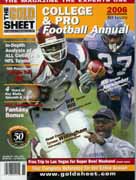
Point Spread Playbook

Gold Sheet College and Pro Football Annual
Points Spread Playbook; Iskoe Reports; Gold Sheet Magazine At GBC Now
Are you ready for the 2006 pro and college football season? Of course not. Baseball's still rolling. Basketball and hockey are finally winding down. And the heart of summer’s heat hasn’t Howard Schwartz, the "librarian for gamblers," is the marketing director for Gambler's Book Club in Las Vegas, a position he has held since 1979. Author of hundreds of articles on gambling, his weekly book reviews appear in numerous publications throughout the gaming industry. Howard's website is www.gamblersbook.com hit us yet, so why would we be ready. But, this is the perfect time to do your homework by looking for soft schedules; evaluating the impact of trades; projecting who'll win how many games; ferreting out future bet sleepers and trying to determine who takes exhibition games seriously -- among other considerations.
Howard Schwartz, the "librarian for gamblers," is the marketing director for Gambler's Book Club in Las Vegas, a position he has held since 1979. Author of hundreds of articles on gambling, his weekly book reviews appear in numerous publications throughout the gaming industry. Howard's website is www.gamblersbook.com hit us yet, so why would we be ready. But, this is the perfect time to do your homework by looking for soft schedules; evaluating the impact of trades; projecting who'll win how many games; ferreting out future bet sleepers and trying to determine who takes exhibition games seriously -- among other considerations.
In keeping with the theme that winners are produced by preparation and discipline, here are four important resources to consider:
Al O'Donnell's Pro Football Point Spread Playbook: 2006 edition (113 pages, paperbound, $19.95). The Illinois-based O'Donnell has his 28th annual edition out ahead of the pack with hundreds of potential betting angles for sides and totals, plus schedules, room to keep records. O'Donnell doesn't tell you who to bet -- for or against. His strength is to just present the facts, telling you how a team performed at home or away for past seasons, who they dominated or who has the edge over them in regard to spreads or in overs and unders. The book contains pointspread histories for the past three years for each pro team plus a clear indication of the type of surface the game was played on, what the total number was and if the game score went over or under. You'll be able to see, in summary form, how teams performed overall on Monday night (as a favorite or dog, home and away), on grass or turf each of the last three seasons and overall for the period, and how well they did versus division and conference teams.
O'Donnell's book makes it easy to double as a record-keeper as well, with an instant look at the schedule, whether the game is against a division or conference rival or inter-conference; on turf or grass, with room for results and whether a team covered or went under or over. There's a handy little section comparing the money line to the spread; a complete Super Bowl spread and totals history from 1967 to 2006. It also shows how teams performed the following season after a Super Bowl win.
O'Donnell's book is both a gift and reference source for the beginner or seasoned pro.
Another respected handicapper and statistical analyst, Andy Iskoe, has his 2006 editions of the Pro Football Statistical Pattern Report (20 pages, stapled, paperbound, 8x11, $10) and College Football Statistical Pattern Report (16 pages, stapled paperbound, 8x11, $10) ready. Each book answers the question most handicappers ask: What causes teams to cover the pointspread? In an 18-season study of 4,500 pro games and more than 11,000 college games, Iskoe examine the key offensive and defensive box score statistics; showing you year by year how rushing, passing, turnovers, total yards affect performance and why the team covered. Double-edged powerhouses, which can rush and pass yet are capable of stopping their opponent from moving the ball, are clearly most effective in covering the spread. This is a thinking-man's approach to handicapping a game. It involves using statistics and past performances, while saving the handicapper countless hours of testing theories and angles.
Iskoe offers illuminating examples and guides the handicapper with a formula, a technique for incorporating a variety of factors. In effect he is showing you that handicapping is both an art and a science.
The college section begins on page 90 with a recruiting ranking for each team (Texas and Florida State rank 1-2); with a review of major conferences, then a look at each conference team, including four years of spreads, Totals for each. The projected starting lineups (offense and defense) for each team are provided, with an indication of returning starters and there's a look at key boxscore statistics for all 2005 games and individual statistical leaders for the team.
For those who yearn for pro and college power ratings, the end of season numbers for each team are on the final page of the magazine including a rating for the home field value (amazingly some stadiums offer quite an edge, with Iowa and Hawaii among the best in the colleges and in the pros, Seattle and Pittsburgh ranked 1-2).

